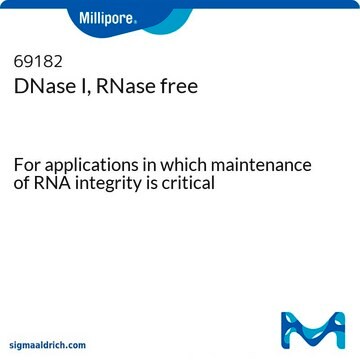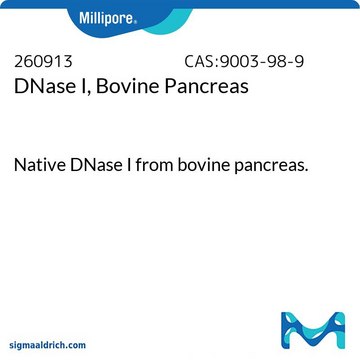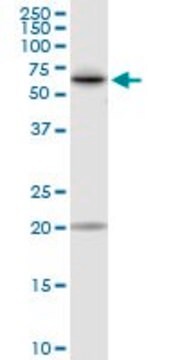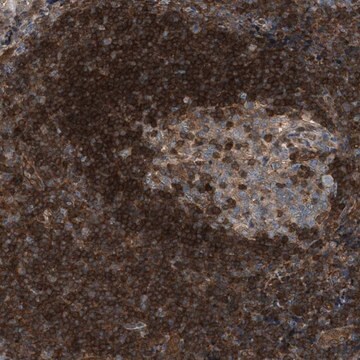AMPD1
DNase I
Amplification Grade
Synonyme(s) :
Deoxyribonuclease I
About This Item
Produits recommandés
Niveau de qualité
Forme
liquid
Concentration
1 unit/μL
Technique(s)
RT-PCR: suitable
Couleur
colorless
Conditions d'expédition
wet ice
Température de stockage
−20°C
Catégories apparentées
Description générale
DNase I digests double- and single-stranded DNA into oligo- and mononucleotides. Using the Reaction Buffer provided, DNA is removed from RNA preparations in a 15 minute digestion at room temperature. The DNase I is then inactivated by heating with the Stop Solution. Heating also denatures hairpins in the RNA, so the RNA can be used directly in reverse transcription.
No current RNA isolation procedure removes 100% of the DNA. Many commercial DNase I formulations are contaminated with residual RNases. This RNase contamination can destroy or degrade valuable RNA samples prior to reverse transcription. Laboratory comparisons have shown that Sigma′s Amplification Grade DNase I demonstrates lower RNase activity than that from several leading molecular biology product suppliers.
Application
- for the digestion of DNA during isolation and purification of RNA. The purified RNA can be used for the synthesis of cDNA using RNA reverse transcriptase.
- to hydrolyze extracellular matrix (ECM) components and enhance photosensitizer penetration into the biofilm to determine the efficacy of antimicrobial photodynamic therapy (aPDT) on Candida albicans biofilms
- to remove contaminating DNA from total RNA extracted from cattle blood samples
Caractéristiques et avantages
- Suitable for the elimination of DNA from RNA
- Minimal RNase activity available
- Optimized 10× reaction buffer and Stop Solution for complete inactivation of DNase I
Adéquation
Définition de l'unité
Informations légales
Inhibiteur
Produit(s) apparenté(s)
Code de la classe de stockage
10 - Combustible liquids
Point d'éclair (°F)
Not applicable
Point d'éclair (°C)
Not applicable
Certificats d'analyse (COA)
Recherchez un Certificats d'analyse (COA) en saisissant le numéro de lot du produit. Les numéros de lot figurent sur l'étiquette du produit après les mots "Lot" ou "Batch".
Déjà en possession de ce produit ?
Retrouvez la documentation relative aux produits que vous avez récemment achetés dans la Bibliothèque de documents.
Les clients ont également consulté
Protocoles
The SeqPlex RNA Amplification kit provides a method for amplification of total RNA or isolated mRNA prior to entry into the workflows of the commonly used deep sequencing platforms.
Method for reverse transcription of RNA into DNA. Uses a premixed reagent that contains reverse transcriptase, dNTPs, primers, RNase inhibitor and buffer. Fast generation of cDNA.
Contenu apparenté
La réaction en chaîne par polymérase (PCR pour "Polymerase Chain Reaction") est une technique d'amplification des molécules d'acide nucléique qui est couramment employée dans de nombreuses applications, incluant la RT-PCR, la PCR à démarrage à chaud, la PCR en point final, et bien d'autres.
Polymerase chain reaction (PCR) is a technique for amplifying nucleic acid molecules and is commonly used in many applications, including RT-PCR, hot start PCR, end point PCR and more.
Notre équipe de scientifiques dispose d'une expérience dans tous les secteurs de la recherche, notamment en sciences de la vie, science des matériaux, synthèse chimique, chromatographie, analyse et dans de nombreux autres domaines..
Contacter notre Service technique












